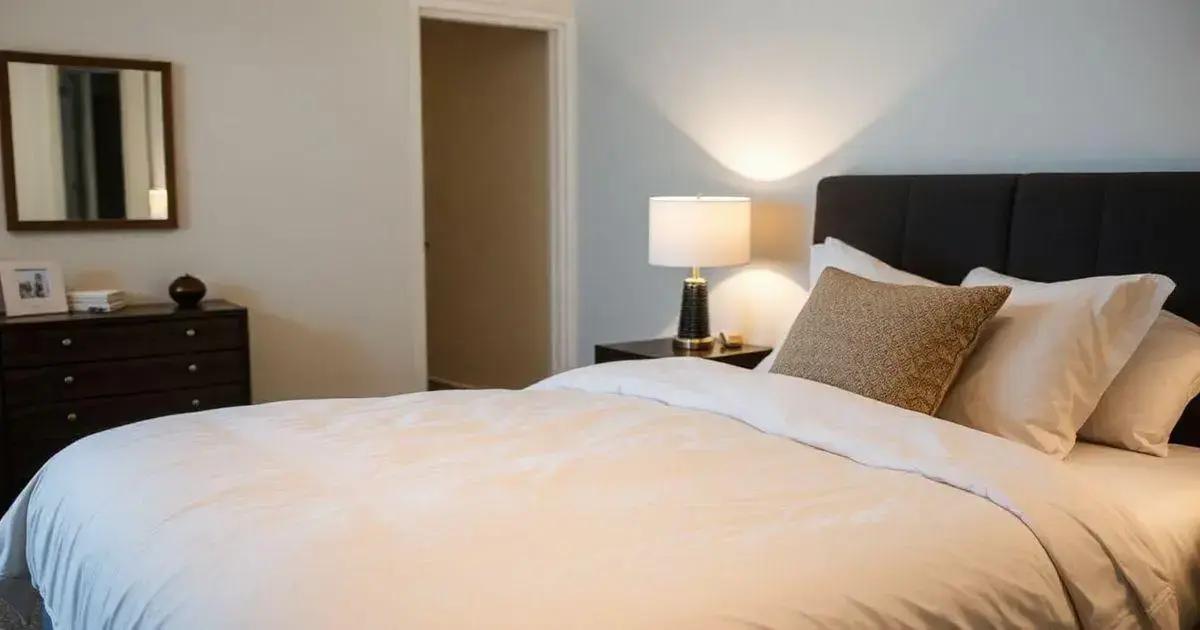Creating a comfortable sleep environment is crucial for improving the quality of your rest. Key elements include choosing the right bedding, controlling lighting and noise, maintaining an optimal temperature, and keeping the space clean and organized. By implementing effective tips and strategies, you can enhance your sleep comfort and overall well-being.
Creating a comfortable sleep environment is vital for achieving quality rest. Many people underestimate how important their bedroom setup is for sound sleep. From the right mattress to ideal lighting, understanding the components that contribute to a peaceful night’s sleep can greatly enhance your overall well-being. In this article, we will discuss why sleep comfort is essential, explore key elements of your bedroom that promote relaxation, provide practical tips for optimizing your sleep space, and talk about how to maintain comfort throughout the night.
Why Comfortable Sleep is Essential

Getting enough comfortable sleep is critical for both physical and mental health. When you sleep well, your body gets a chance to repair itself, and your mind stays sharp. Quality Sleep Benefits include improved mood, better memory, and increased focus. Comfortable sleep can also reduce stress and anxiety levels, allowing you to feel more relaxed during the day.
Physical Health Advantages
Comfortable sleep helps regulate hormones that control appetite and metabolism. A well-rested body is less likely to suffer from diseases like obesity, diabetes, and heart issues. Moreover, when you create a sleep environment tailored to your comfort, it enhances your body’s recovery processes.
Mental Well-Being
Sleep affects your brain’s ability to function effectively. A good sleep environment leads to deeper sleep, which is essential for the brain to process information. If you feel rested, you can manage stress better and have a more positive outlook on life.
Overall Life Quality
When you prioritize a comfortable sleep environment, you enhance your overall quality of life. People with better sleep report feeling happier and reaching their goals more easily. Creating a sanctuary for sleep allows you to awaken refreshed and eager to take on daily challenges.
Elements of a Sleep-Friendly Bedroom

A sleep-friendly bedroom can greatly influence how well you sleep. Many elements contribute to creating this optimal environment. Comfortable Bedding is the first key factor. A good mattress and pillows that support your head and neck help reduce discomfort, allowing your body to relax. Invest in quality sheets that feel soft and breathable against your skin.
Lighting Control
Proper lighting is essential for a restful sleep space. Your bedroom should be dark enough to promote deep sleep. Consider using blackout curtains to block outside light. Additionally, avoid using bright screens before bedtime, as they can disrupt your body’s natural sleep-wake cycle.
Temperature Regulation
The ideal temperature for sleeping is usually between 60 and 67 degrees Fahrenheit. A room that is too hot or too cold can disturb your sleep. Use fans or air conditioning to keep the air fresh and comfortable. Make sure to choose blankets or quilts appropriate for the season.
Decluttered Space
Lastly, a tidy room can significantly enhance your sleep quality. Clutter can cause anxiety and prevent you from fully relaxing. Keep your bedroom organized and free from unnecessary distractions. Adding calming elements such as plants or comforting decor can also create a soothing atmosphere.
Tips for Optimizing Sleep Environment

Optimizing your sleep environment is key to improving the quality of your rest. Here are some effective tips to create a better sleep setting:
1. Invest in Quality Bedding
Your bed should be a haven of comfort. Choose a supportive mattress and pillows that match your sleeping style. Soft, breathable sheets will also help keep you cozy and comfortable throughout the night.
2. Control Noise Levels
Minimize noise disturbances to enhance your sleep quality. Use earplugs or a white noise machine to block out distracting sounds. You can also consider playing soothing music or nature sounds to create a relaxing atmosphere.
3. Optimize Lighting
Lighting can greatly impact your ability to fall asleep. Use blackout curtains to darken your room and avoid bright lights before bedtime. A soft night light can be helpful when you need to get up during the night.
4. Maintain a Clean Environment
A clean and tidy bedroom contributes to better sleep. Regularly wash your bedding and keep your sleeping space organized. A clutter-free area helps reduce anxiety and prepares your mind for rest.
Implementing these tips can transform your sleep environment, making it easier to enjoy restful nights and rejuvenating mornings.
How to Maintain Comfort Throughout the Night

Maintaining comfort throughout the night is essential for quality sleep. Here are some effective strategies to keep your sleep environment cozy.
1. Adjust Bedding Based on Seasons
Use appropriate bedding for the season. In colder months, opt for thicker blankets and flannel sheets. During warmer months, choose lighter materials like cotton or linen to prevent overheating.
2. Stay Hydrated
Keep a glass of water by your bedside, but be cautious not to drink too much before sleep. Staying hydrated helps your body regulate temperature throughout the night. Just remember to manage your intake to avoid middle-of-the-night trips to the bathroom!
3. Monitor Your Sleep Position
How you sleep can impact your comfort levels. Use supportive pillows to keep your neck in a neutral position. Consider switching sleeping positions if you start to feel uncomfortable. A different pillow arrangement can also help relieve pressure points.
4. Use Aromatherapy or Scented Items
Calming scents, such as lavender or chamomile, can create a relaxing environment. Use essential oil diffusers, scented candles, or linen sprays to infuse your space with pleasant aromas.
Implementing these strategies can help you maintain a comfortable sleep environment, allowing for a restful and uninterrupted night.
Creating a Comfortable Sleep Environment is Essential
In conclusion, establishing a comfortable sleep environment is vital for achieving quality rest and improving overall well-being. The elements of your bedroom, such as bedding, lighting, and cleanliness, play a crucial role in enhancing sleep quality.
Additionally, by implementing tips to optimize your space and maintain comfort throughout the night, you can ensure that your sleep is undisturbed and restorative. Prioritizing sleep comfort not only boosts your mood and energy levels but also contributes significantly to your long-term health.
By dedicating time to perfect your sleep environment, you set the stage for restful nights and revitalizing mornings, allowing you to tackle your daily responsibilities with vigor.
FAQ – Frequently Asked Questions about Creating a Comfortable Sleep Environment
Why is a comfortable sleep environment important?
A comfortable sleep environment is essential for achieving quality rest, which positively impacts your mood, energy levels, and overall health.
What are the key elements of a sleep-friendly bedroom?
Key elements include a comfortable mattress and pillows, controlled lighting, reduced noise levels, and a clean, organized space.
How can I optimize my sleep environment?
You can optimize your sleep environment by investing in quality bedding, controlling noise and lighting, and keeping your bedroom tidy.
What are some tips for maintaining comfort throughout the night?
To maintain comfort, adjust bedding according to the season, stay hydrated, monitor your sleep position, and use calming scents.
How does temperature affect sleep quality?
The ideal sleeping temperature is around 60 to 67 degrees Fahrenheit. Too hot or too cold can disturb your sleep.
Can aromatherapy help improve sleep?
Yes, calming scents like lavender can create a relaxing atmosphere and help promote better sleep.













